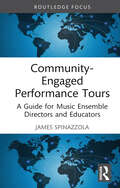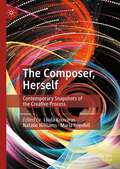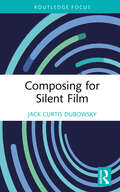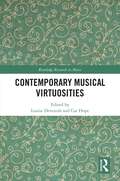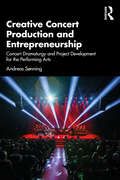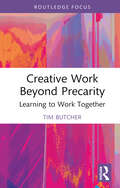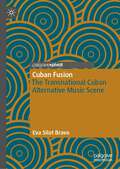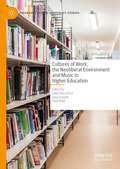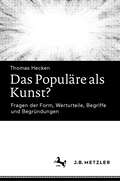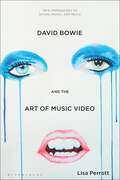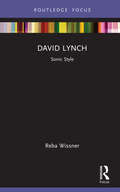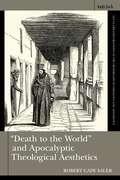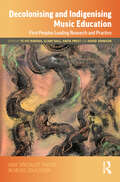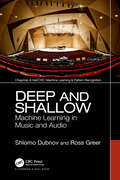- Table View
- List View
Community-Engaged Performance Tours: A Guide for Music Ensemble Directors and Educators
by James SpinazzolaCommunity-Engaged Performance Tours addresses the role of performance touring as a form of classroom and community engagement. Performance tours have long been a part of the collegiate and high school music ensemble experience, bringing student bands, choirs, and orchestras into connection with a wide variety of audiences, venues, and cultural contexts. This book presents a new approach to the performance tour that integrates touring with community engagement and service-learning. Emphasizing reciprocity, cross-cultural exchange, and global awareness, the author addresses how visiting ensembles can work with host communities instead of performing for them. The book includes student and community perspectives and case studies from the author’s experience leading university wind symphony tours in Haiti and the Dominican Republic, and provides a practical and hands-on model for ensemble leaders and educators.
Community-Engaged Performance Tours: A Guide for Music Ensemble Directors and Educators
by James SpinazzolaCommunity-Engaged Performance Tours addresses the role of performance touring as a form of classroom and community engagement. Performance tours have long been a part of the collegiate and high school music ensemble experience, bringing student bands, choirs, and orchestras into connection with a wide variety of audiences, venues, and cultural contexts. This book presents a new approach to the performance tour that integrates touring with community engagement and service-learning. Emphasizing reciprocity, cross-cultural exchange, and global awareness, the author addresses how visiting ensembles can work with host communities instead of performing for them. The book includes student and community perspectives and case studies from the author’s experience leading university wind symphony tours in Haiti and the Dominican Republic, and provides a practical and hands-on model for ensemble leaders and educators.
The Composer, Herself: Contemporary Snapshots of the Creative Process
by Linda Kouvaras Natalie Williams Maria GrenfellThis edited volume presents 27 original essays by living composers from all around the globe, reflecting on the creation of their music. Coterminous to the recent worldwide resurgence in feminist focus, the distinctive feature of this collection is the “snapshots” of creative processes and conceptualizing on the part of women who write music, writing in the present day, from prominent early-career composers to major figures, from a range of ethnic backgrounds in the contemporary music field. The chapters step into the juncture point at which feminism finds itself: as binary conceptions of gender are being dissolved, with critiques of the attendant gender-based historical generalizations of composers, and with the growing awareness of the rightful place of First Nations' cultural voices, the contributors explore what, actually, is being composed by women, and what they think about their world. The needs that this book serves are acutely felt: despite recent social gains, and sector initiatives and programs encouraging and presenting the work of women who compose music, their works are yet to receive commensurate exposure with that of their male counterparts. In its multi-pronged, direct response to this dire situation, this vibrant volume highlights established as well as emerging women composers on the international stage; reveals myriad issues around feminism, as broadly conceived; and gives insights, from the composers' own voices, on the inner workings of their composition process.The volume thus presents a contemporary moment in time across the generations and within developments in musical composition. With its unique insights, this book is essential for academics and practitioners interested in the illuminations of the current working landscape for creative women.
Composing for Silent Film
by Jack Curtis DubowskyComposing for Silent Film offers insight, information, and techniques for contemporary composition, arrangement, and live score performance for period silent film. A specialized music composition guide, this book complements existing film scoring and contemporary music composition texts. This book helps today’s composers better understand and correctly interpret period silent film, and to create and perform live scores that align with films’ original intentions, so that audiences notice and grasp fine points of the original film. Composing for Silent Film analyzes period silent film and its conventions – from Delsarte acting gestures to period fascinations and subtexts. As a practical composition text, it weighs varying approaches, including improvisation, through-scoring, "mickey-mousing," handling dialogue, and dividing roles amongst players. It steers composers towards informed understanding of silent film, and encourages them to deploy contemporary styles and techniques in exciting ways.For clarity and concision, examples are limited to nine canonical silents: Metropolis, Dr. Jekyll and Mr. Hyde, The Mark of Zorro, Sunrise: A Song of Two Humans, The Black Pirate, Nosferatu, The Phantom Carriage, Daisy Doodad’s Dial, and The Golem.
Composing for Silent Film
by Jack Curtis DubowskyComposing for Silent Film offers insight, information, and techniques for contemporary composition, arrangement, and live score performance for period silent film. A specialized music composition guide, this book complements existing film scoring and contemporary music composition texts. This book helps today’s composers better understand and correctly interpret period silent film, and to create and perform live scores that align with films’ original intentions, so that audiences notice and grasp fine points of the original film. Composing for Silent Film analyzes period silent film and its conventions – from Delsarte acting gestures to period fascinations and subtexts. As a practical composition text, it weighs varying approaches, including improvisation, through-scoring, "mickey-mousing," handling dialogue, and dividing roles amongst players. It steers composers towards informed understanding of silent film, and encourages them to deploy contemporary styles and techniques in exciting ways.For clarity and concision, examples are limited to nine canonical silents: Metropolis, Dr. Jekyll and Mr. Hyde, The Mark of Zorro, Sunrise: A Song of Two Humans, The Black Pirate, Nosferatu, The Phantom Carriage, Daisy Doodad’s Dial, and The Golem.
Contemporary Musical Virtuosities (Routledge Research in Music)
by Louise Devenish Cat HopeContemporary notions of musical virtuosity redevelop historic concepts and demonstrate that our present understanding of virtuosity in western art music has shifted from what seemed, for a time, to be a relatively clear and stable definition. In the field and the academy, lively debates around the definition and/or value of virtuosity have always elicited strong and varied ideas. In the twenty-first century, frictions have emerged between traditional definitions of virtuosity and contemporary practices that emphasise collaboration and blur roles between performers, composers, and improvisers. Contemporary Musical Virtuosities embraces the evolving processes, practitioners, and presentation models within twenty-first century art music. This edited collection explores recent insights into the experience and role of virtuosity in different contexts, via contributions from an intergenerational group of artists, academics, and artist-academics. Their writing highlights current themes in contemporary western art music and intersecting musical and performing arts genres such as dance, sound art, improvisation, jazz, trans-traditional collaborations, and Australian Indigenous music. It offers models for supporting and recognising a plurality of musical virtuosities typically excluded from traditional definitions and examines implications for musical practice today. Chapters take the form of academic essays, artist reflections, interviews, personal letters, and a manifesto, reflecting the range of approaches and contexts covered. The collection includes first writings on practices that have been present in the industry for some time not yet documented or examined in detail until now, and thus offers a vision for the future that prioritises inclusive and overlapping practices and processes in music.
Contemporary Musical Virtuosities (Routledge Research in Music)
by Louise DevenishContemporary notions of musical virtuosity redevelop historic concepts and demonstrate that our present understanding of virtuosity in western art music has shifted from what seemed, for a time, to be a relatively clear and stable definition. In the field and the academy, lively debates around the definition and/or value of virtuosity have always elicited strong and varied ideas. In the twenty-first century, frictions have emerged between traditional definitions of virtuosity and contemporary practices that emphasise collaboration and blur roles between performers, composers, and improvisers. Contemporary Musical Virtuosities embraces the evolving processes, practitioners, and presentation models within twenty-first century art music. This edited collection explores recent insights into the experience and role of virtuosity in different contexts, via contributions from an intergenerational group of artists, academics, and artist-academics. Their writing highlights current themes in contemporary western art music and intersecting musical and performing arts genres such as dance, sound art, improvisation, jazz, trans-traditional collaborations, and Australian Indigenous music. It offers models for supporting and recognising a plurality of musical virtuosities typically excluded from traditional definitions and examines implications for musical practice today. Chapters take the form of academic essays, artist reflections, interviews, personal letters, and a manifesto, reflecting the range of approaches and contexts covered. The collection includes first writings on practices that have been present in the industry for some time not yet documented or examined in detail until now, and thus offers a vision for the future that prioritises inclusive and overlapping practices and processes in music.
Creative Concert Production and Entrepreneurship: Concert Dramaturgy and Project Development for the Performing Arts
by Andreas SonningCreative Concert Production and Entrepreneurship: Concert Dramaturgy and Project Development for the Performing Arts offers a conceptual and applied introduction to the musical and dramaturgical challenges involved in developing and producing concerts. Drawing from over three decades of real-world experience and a range of international case studies, the author explores new models for cooperation between artists, cultural institutions, governments, and businesses, arguing for the importance of rooting the concert production process in artistic and ethical values. The book presents essential knowledge and techniques to meet the demand for music and stage performances across genres, arenas, formats, and distribution channels. Relevant to a wide range of students and professionals in music and the performing arts, Creative Concert Production and Entrepreneurship marries theory with practice, providing a framework for readers to develop the creative entrepreneurial practices essential for success in today’s music industry.
Creative Concert Production and Entrepreneurship: Concert Dramaturgy and Project Development for the Performing Arts
by Andreas SonningCreative Concert Production and Entrepreneurship: Concert Dramaturgy and Project Development for the Performing Arts offers a conceptual and applied introduction to the musical and dramaturgical challenges involved in developing and producing concerts. Drawing from over three decades of real-world experience and a range of international case studies, the author explores new models for cooperation between artists, cultural institutions, governments, and businesses, arguing for the importance of rooting the concert production process in artistic and ethical values. The book presents essential knowledge and techniques to meet the demand for music and stage performances across genres, arenas, formats, and distribution channels. Relevant to a wide range of students and professionals in music and the performing arts, Creative Concert Production and Entrepreneurship marries theory with practice, providing a framework for readers to develop the creative entrepreneurial practices essential for success in today’s music industry.
Creative Work Beyond Precarity: Learning to Work Together (Routledge Focus on the Global Creative Economy)
by Tim ButcherThis book offers an original critical evaluation of how freelance careers can be established and sustained in the increasingly uncertain global creative economy. Developing from the author’s theoretical and empirical research at the nexus of precarious work and entrepreneurial learning, it provides an in-depth understanding of why and how creatives can learn to become entrepreneurial and how this relates to creative entrepreneurship. This book traces how arts work became creative labour and explores the contemporary organisation of artistic and creative practices to understand practical alternatives to the individualised careers we currently feel responsible for maintaining. Inspired particularly by the work of Raymond Williams, creative work is reconceptualised as practice-based collaborative learning encounters through which we might put shared feelings of precarity to work towards the production and practice of alternative possibilities. Accessible and concise, breaking down complex concepts through practical examples and linking the creative process to entrepreneurial learning, this book will be of interest to students, educators and researchers studying and working in the creative economy.
Creative Work Beyond Precarity: Learning to Work Together (Routledge Focus on the Global Creative Economy)
by Tim ButcherThis book offers an original critical evaluation of how freelance careers can be established and sustained in the increasingly uncertain global creative economy. Developing from the author’s theoretical and empirical research at the nexus of precarious work and entrepreneurial learning, it provides an in-depth understanding of why and how creatives can learn to become entrepreneurial and how this relates to creative entrepreneurship. This book traces how arts work became creative labour and explores the contemporary organisation of artistic and creative practices to understand practical alternatives to the individualised careers we currently feel responsible for maintaining. Inspired particularly by the work of Raymond Williams, creative work is reconceptualised as practice-based collaborative learning encounters through which we might put shared feelings of precarity to work towards the production and practice of alternative possibilities. Accessible and concise, breaking down complex concepts through practical examples and linking the creative process to entrepreneurial learning, this book will be of interest to students, educators and researchers studying and working in the creative economy.
Cuban Fusion: The Transnational Cuban Alternative Music Scene
by Eva Silot BravoSurveying the impact of Cuba's economic crisis after the demise of the eastern socialist block, this book documents a relatively unexplored transnational network of collaborations among Cuban musicians that migrated to many different countries from the 1990s forward. The book’s main argument is that in light of the 1990s crisis in Cuba, new transnational and alternative narratives emerged, resulting in creative “in-between” spaces that reflect a post- socialist aesthetic condition. The manuscript also documents important developments in the Cuban jazz and fusion scenes outside the island in the last 20+ years..
Cultures of Work, the Neoliberal Environment and Music in Higher Education (Palgrave Critical University Studies)
by Sally Macarthur Julja Szuster Paul WattThis edited book considers the impact of neoliberalism on music teaching, research and scholarship in a higher education context. As a subject that bears little resemblance to other university practical disciplines, and fares poorly in a model driven by economics, the book considers whether musicology is a ‘public good’ or a threatened species. It contemplates what musicology can usefully contribute to a paradigm driven by economics, and questions whether it is ever possible to recover an ideal civil subject in neoliberal music academia. Contributions investigate what it means to build music research capacity in innovative ways, such as forging cross-cultural relationships, subverting conventional notions of quality and value, replacing them with knowledges and values that guide Indigenous intellectual traditions, and whether interventions into the legacy of colonialism are truly ever possible in neoliberal higher education institutions that celebrate difference and diversitywhile reinforcing social inequities. The book also explores the relationships between gender and music, music research training and scholarship, and whether the interdisciplinarity championed by the university is ever workable. Finally, it undertakes a cross-disciplinary, new materialist reading of a canonical musical work, offering a radically new perspective. The book will appeal to students and scholars of music education, musicology, higher education studies and the creative arts more broadly.
D. O. DOUBLE G: The Og Since 1993 (The\little Book Of... Ser.)
by Orange Hippo!America's Original Gangsta. Snoop Doggy Dogg fired up the burgeoning U.S. rap scene in 1993 with his outstanding debut, Doggystyle. It not only revolutionised a genre, it also put West Coast ganstas at the top of the charts for the first time ever. With producer Dr Dre, Snoop lit the spark for many other famous rappers to find fame and built a global apparel empire and brand that now branches out into multiple bestselling products, all available on his online 'Snoopermarket'.This little guide is the pick-me-up every Snoop fan deserves. With more than 175 whip smart wisecracks from America's highest pop culture power, The Little Guide to Snoop Dogg is the best way to celebrate 30 years of Doggystyle without putting your back out.'I felt like I was out of pocket. I apologised to him, and let him know and I'm just bettering myself. I make mistakes. I ain't perfect. I'm Snoop Dogg.'
Das auditive Netz: Künstlerische Forschung im medialen Dazwischen (Musik und Klangkultur #69)
by Hans-Ulrich WernerWas macht künstlerisches Forschen im Bereich Sound und Musik aus? Im Ausklang einer langen und produktiven technisch-künstlerischen sowie wissenschaftlichen Laufbahn stellt Hans-Ulrich Werner seine Ergebnisse zum Thema vor. Dazu orientiert er sich vor allem an den Ideen und Erkenntnissen der Menschen, denen er bei seinem Schaffen begegnete und die er als Akteure eines internationalen Netzes beschreibt. Somit ergibt sich nicht nur ein Einblick in die Protagonisten der vielfältigen Klanglandschaften dieser Welt, sondern auch die Etablierung des künstlerischen Forschens als eigenständige Disziplin jenseits von klassischer Wissenschaft.
Das Populäre als Kunst?: Fragen der Form, Werturteile, Begriffe und Begründungen
by Thomas HeckenPopulären Werken wird seit Jahrhunderten der Status des Kunstwerks aberkannt, unter Verweis auf deren vermeintliche Oberflächlichkeit, Eindimensionalität, Effekthascherei und Standardisierung werden sie streng von ‚echter‘ Kunst geschieden. Schiller, Nietzsche, Adorno, Greenberg, unzählige Kritiker und Feuilletonisten in Westeuropa und den USA – sie alle eint ein starker Vorbehalt gegenüber dem, was von den Vielen anerkannt, geschätzt und gekauft wird. Seit Beginn des 18. Jahrhunderts und besonders seit den 1950er Jahren gibt es aber auch eine Reihe von Argumenten gegen die Auffassung, dass nichts Kunst sei, was auf große Zustimmung trifft. Die Fülle an unterschiedlichen Positionen, Aussagen und Argumentationsmöglichkeiten aufzuzeigen, zu bündeln, zu systematisieren und zu überprüfen, die dem Populären zu künstlerischer Anerkennung verhelfen wollen, ist Zweck dieses Buches. Das Resultat ist eine umfassende Darstellung von Gründen, auch populäre Werke aus Literatur, Musik, Film,Fotografie, bildender Kunst und Design als genuine Kunstwerke betrachten zu können.
Das Revival der traditionellen gälischen Musik Schottlands: Die Bands Runrig und Capercaillie (Musik und Klangkultur #70)
by Martin SchröderDie traditionelle gälische Musik Schottlands feiert ein Revival. Martin Schröder betrachtet mit Runrig und Capercaillie zwei der bedeutendsten Folkgruppen des Landes. Dabei analysiert er erstmals deren Werk und das ihrer musikalischen Wegbereiter und untersucht es im Kontext musikalischer Revivalbewegungen. Mithilfe zeitgenössischer Zeitungs- und Zeitschriftenartikel, Rezensionen, zahlreicher Transkriptionen von Ausschnitten der Werke beider Bands sowie einer Vielzahl von Interviews, u.a. mit dem Runrig-Gründer Calum Macdonald und dem ehemaligen Leadsänger Donnie Munro, zeichnet er so ein vielgestaltiges Meinungsbild zur Entwicklung der traditionellen gälischen Musik in Geschichte und Gegenwart.
David Bowie and the Art of Music Video (New Approaches to Sound, Music, and Media)
by Dr. Lisa PerrottThe first in-depth study of David Bowie's music videos across a sustained period takes on interweaving storyworlds of an iconic career. Remarkable for their capacity to conjure elaborate imagery, Bowie's videos provide fascinating exemplars of the artistry and remediation of music video. When their construction is examined across several years, they appear as time-travelling vessels, transporting kooky characters and strange story-world components across time and space. By charting Bowie's creative and collaborative process across five distinct phases, David Bowie and the Art of Music Video shows how he played a vital role in establishing music video as an artform. Filling a gap in the existing literature, this book shines a light on the significant contributions of directors such as Mick Rock, Stanley Dorfman and David Mallet, each of whom taught Bowie much about how to use the form. By examining Bowie's collaborative process, his use of surrealist strategies and his integration of avant-garde art with popular music and media, the book provides a history of music video in relation to the broader fields of audiovisual media, visual music and art.
David Lynch: Sonic Style (Filmmakers and Their Soundtracks)
by Reba WissnerDirector David Lynch is best known for films that channel the uncanny and the weird into a distinct "Lynchian" aesthetic, in which sound and music play a key role: Lynch not only writes his intended sounds into the script but also often takes on the role of creating the sounds himself. This concise study explores what makes Lynch’s sonic imprint distinct, breaking down three different sound styles that create Lynch’s sound aesthetic across his films. Showing how sound offers new insights into the aesthetic and narrative work of Lynch’s filmmaking, this book highlights new dimensions in the work of a key American auteur and deconstructs the process of building a unique sound world.
David Lynch: Sonic Style (Filmmakers and Their Soundtracks)
by Reba WissnerDirector David Lynch is best known for films that channel the uncanny and the weird into a distinct "Lynchian" aesthetic, in which sound and music play a key role: Lynch not only writes his intended sounds into the script but also often takes on the role of creating the sounds himself. This concise study explores what makes Lynch’s sonic imprint distinct, breaking down three different sound styles that create Lynch’s sound aesthetic across his films. Showing how sound offers new insights into the aesthetic and narrative work of Lynch’s filmmaking, this book highlights new dimensions in the work of a key American auteur and deconstructs the process of building a unique sound world.
"Death to the World" and Apocalyptic Theological Aesthetics (T&T Clark Explorations at the Crossroads of Theology and Aesthetics)
by Robert Cady SalerRobert Saler examines the small but influential Death to the World movement in US Eastern Orthodox Christianity. Presenting a case study in theological aesthetics, Saler demonstrates how a relatively small consumer phenomenon within US Eastern Orthodoxy sits at the centre of a variety of larger questions, including:- The relationship between formal ecclesial and para-church structures - The role of the Internet in modern religiosity - Consumer structures and patterns as constitutive of piety- How theology can help us understand art and vice versaUnderstanding "Death to the World" as an instance of lived religion tied to questions of identity, politics of religious purity, relationships to capitalism, and concerns over conspiracy theory helps us to see how studies of uniquely American Eastern Orthodox identity must address these broader cultural strands.
Decolonising and Indigenising Music Education: First Peoples Leading Research and Practice (ISME Series in Music Education)
by Te Oti Rakena Clare Hall Anita Prest David JohnsonCentring the voices of Indigenous scholars at the intersection of music and education, this co-edited volume contributes to debates about current colonising music education research and practices, and offers alternative decolonising approaches that support music education imbued with Indigenous perspectives. This unique collection is far-ranging, with contributions from Chile, New Zealand, Australia, Canada, Malaysia, India, South Africa, Kenya, and Finland. The authors interrogate and theorise research methodologies, curricula, and practices related to the learning and teaching of music. Providing a meeting place for Indigenous voices and viewpoints from around the globe, this book highlights the imperative that Indigenisation must be Indigenous-led.The book promotes Indigenous scholars’ reconceptualisations of how music education is researched and practised, with an emphasis on the application of decolonial ways of being. The authors provocatively demonstrate the value of power-sharing and eroding the gaze of non-Indigenous populations. Pushing far beyond the concepts of Western aesthetics and world music, this vital collection of scholarship presents music in education as a social and political action, and shows how to enact Indigenising and decolonising practices in a wide range of music education contexts.
Decolonising and Indigenising Music Education: First Peoples Leading Research and Practice (ISME Series in Music Education)
by Te Oti Rakena, Clare Hall, Anita Prest and David JohnsonCentring the voices of Indigenous scholars at the intersection of music and education, this co-edited volume contributes to debates about current colonising music education research and practices, and offers alternative decolonising approaches that support music education imbued with Indigenous perspectives. This unique collection is far-ranging, with contributions from Chile, New Zealand, Australia, Canada, Malaysia, India, South Africa, Kenya, and Finland. The authors interrogate and theorise research methodologies, curricula, and practices related to the learning and teaching of music. Providing a meeting place for Indigenous voices and viewpoints from around the globe, this book highlights the imperative that Indigenisation must be Indigenous-led.The book promotes Indigenous scholars’ reconceptualisations of how music education is researched and practised, with an emphasis on the application of decolonial ways of being. The authors provocatively demonstrate the value of power-sharing and eroding the gaze of non-Indigenous populations. Pushing far beyond the concepts of Western aesthetics and world music, this vital collection of scholarship presents music in education as a social and political action, and shows how to enact Indigenising and decolonising practices in a wide range of music education contexts.
Deep and Shallow: Machine Learning in Music and Audio
by Shlomo Dubnov Ross GreerProviding an essential and unique bridge between the theories of signal processing, machine learning, and artificial intelligence (AI) in music, this book provides a holistic overview of foundational ideas in music, from the physical and mathematical properties of sound to symbolic representations. Combining signals and language models in one place, this book explores how sound may be represented and manipulated by computer systems, and how our devices may come to recognize particular sonic patterns as musically meaningful or creative through the lens of information theory. Introducing popular fundamental ideas in AI at a comfortable pace, more complex discussions around implementations and implications in musical creativity are gradually incorporated as the book progresses. Each chapter is accompanied by guided programming activities designed to familiarize readers with practical implications of discussed theory, without the frustrations of free-form coding. Surveying state-of-the art methods in applications of deep neural networks to audio and sound computing, as well as offering a research perspective that suggests future challenges in music and AI research, this book appeals to both students of AI and music, as well as industry professionals in the fields of machine learning, music, and AI.
Deep and Shallow: Machine Learning in Music and Audio
by Shlomo Dubnov Ross GreerProviding an essential and unique bridge between the theories of signal processing, machine learning, and artificial intelligence (AI) in music, this book provides a holistic overview of foundational ideas in music, from the physical and mathematical properties of sound to symbolic representations. Combining signals and language models in one place, this book explores how sound may be represented and manipulated by computer systems, and how our devices may come to recognize particular sonic patterns as musically meaningful or creative through the lens of information theory. Introducing popular fundamental ideas in AI at a comfortable pace, more complex discussions around implementations and implications in musical creativity are gradually incorporated as the book progresses. Each chapter is accompanied by guided programming activities designed to familiarize readers with practical implications of discussed theory, without the frustrations of free-form coding. Surveying state-of-the art methods in applications of deep neural networks to audio and sound computing, as well as offering a research perspective that suggests future challenges in music and AI research, this book appeals to both students of AI and music, as well as industry professionals in the fields of machine learning, music, and AI.
